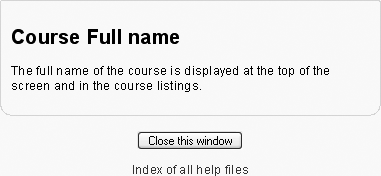In this chapter, we’ll cover the basics of the Moodle interface and some of the options you have when setting up your course. Then we’ll start adding some content to your first Moodle course.
As mentioned in Chapter 1, Moodle is a web-based tool you can access through a web browser. This means that in order to use Moodle, you need a computer with a web browser installed and an Internet connection. You also need to have the web address (called a Uniform Resource Locator, or URL) of a server running Moodle. If your institution supports Moodle, it will have a server with Moodle up and running. You can then get the server address from the system administrator. If you don’t have access to a server with Moodle installed, and you’d like to set up your own, you can download a Moodle package from http://moodle.org/.
When you first visit your Moodle site, you’ll see the front page with the site news and the courses you are teaching or taking (see Figure 2-1).
Take a moment and familiarize yourself with the interface. Moodle uses a number of interface conventions throughout the system. Important information is usually presented in the middle of the screen. On the lefthand side of the screen you’ll see several blocks that list available courses and site news. There are a number of useful blocks installed by default on a Moodle server. Your system administrator may install additional optional blocks to add different functionality.
In the upper-right corner, you may see a drop-down menu with language options. As of September 2007, Moodle has been translated into over 70 languages by the developer community. The number of languages is now so large that Moodle only loads one language by default. Your system administrator can download additional language packs to provide support for new languages. Moodle also supports UTF-8, a standard for the display of non-Latin character sets, like Chinese or Arabic characters. The language features can be useful for learning foreign languages or supporting students from different countries.
Anyone who uses Moodle can select the language in which Moodle’s labels and instructions will appear. For example, if you choose to view the site in Norwegian, the labels and help files will be translated into that language. Moodle does not translate user-generated content—such as forum posts—automatically, though it’s possible to create multilanguage content (see Chapter 3).
You can choose the language settings for the front page and for each course you visit. As an instructor, you can also force students to use a given language. This is a useful feature if you’re teaching a language course and want the entire course to be in that language. Or you can simply confuse the heck out of your students by choosing some really obscure language and have them guess what everything means.
The system administrator can decide not to display the language drop-down menu on the front page. If you want to change the language and find that you cannot, contact your system administrator.
Throughout Moodle, you will see a question mark in a yellow circle. This is a link to Moodle’s very extensive help system. Although you shouldn’t need it very frequently after you read this book, the community has worked hard to provide you with a help system that is tied to what you are doing at that moment.
When you click the question mark icon, a new window pops up with the help file for the item you are asking about (see Figure 2-2). After you read the help file, you can close the window with the “Close this window” button or look at other help files by clicking on the “Index of all help files” link. You can then select any help file from anywhere in the help system.
In addition to the help system, if you are logged in as a teacher or an administrator, you’ll find a “Moodle Docs for this page” link at the bottom of each page. Clicking this link will take you to the corresponding page on http://docs.moodle.org/. Moodle Docs is the documentation for Moodle, written by the Moodle community.

